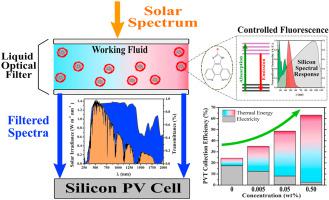当前位置:
X-MOL 学术
›
Sol. Energy Mater. Sol. Cells
›
论文详情
Our official English website, www.x-mol.net, welcomes your
feedback! (Note: you will need to create a separate account there.)
Organic luminescent down-shifting liquid beam splitters for hybrid photovoltaic-thermal (PVT) applications
Solar Energy Materials and Solar Cells ( IF 6.3 ) Pub Date : 2021-01-01 , DOI: 10.1016/j.solmat.2020.110818 James Walshe , Pauraic Mc Carron , Sarah McCormack , John Doran , George Amarandei
Solar Energy Materials and Solar Cells ( IF 6.3 ) Pub Date : 2021-01-01 , DOI: 10.1016/j.solmat.2020.110818 James Walshe , Pauraic Mc Carron , Sarah McCormack , John Doran , George Amarandei

|
Abstract Hybridised photovoltaic-thermal (PVT) systems, obtained by merging photo-voltaic (PV) and photo-thermal (PT) technologies, can lead to enhanced conversion efficiencies. Liquid spectral beam splitters (SBSs) offer control of the ‘thermal’ and ‘electrical’ components of the solar spectrum. Combining PVT systems with liquid SBSs facilitates enhanced control of the thermal and electrical outputs, further improving the PVT systems efficiency and making them economically viable. Traditionally, liquid SBSs contain nanostructures suspended in a base-fluid to capitalise on the enhanced heat transfer capabilities offered by the nanostructures' surface morphology. These nanofluids have certain disadvantages, such as stability problems, environmental hazards and synthetic cost concerns, which preclude them from becoming a viable substitute for commercial (single-phase) fluids. This study offers an alternative strategy by employing a set of newly developed fluids containing organic and organometallic imidazo[4,5-f][1,10]phenanthroline derivatives for SBS-PVT systems. These new working fluids were designed to mimic the behaviour of luminescent down-shifting (LDS) molecules while offering enhanced thermophysical characteristics over the host base-fluid. Their optical, fluorescent and thermophysical properties enabled an increased heating rate within the working fluid. Their integration as working fluids in an SBS-PVT system lead to optical efficiencies of ~63% i.e. an 18%–20% improvement over the standalone PV technology. The fluid properties displayed a 61% increase in the economic value of the energy captured when compared to the host base-fluid alone for the same PVT system. Consequently, these novel fluids and the organic molecules they contain can be effectively designed as high performance spectrally selective fluids for PVT applications.
中文翻译:

用于混合光伏热 (PVT) 应用的有机发光下移液体分束器
摘要 通过合并光伏 (PV) 和光热 (PT) 技术获得的混合光伏热 (PVT) 系统可以提高转换效率。液体光谱分束器 (SBS) 提供对太阳光谱的“热”和“电”分量的控制。将 PVT 系统与液态 SBS 相结合,有助于增强对热输出和电输出的控制,进一步提高 PVT 系统的效率并使其具有经济可行性。传统上,液体 SBS 包含悬浮在基液中的纳米结构,以利用纳米结构表面形态提供的增强的传热能力。这些纳米流体具有某些缺点,例如稳定性问题、环境危害和合成成本问题,这使它们无法成为商业(单相)流体的可行替代品。本研究通过采用一组新开发的含有有机和有机金属咪唑并 [4,5-f][1,10] 菲咯啉衍生物的流体用于 SBS-PVT 系统,提供了一种替代策略。这些新的工作流体旨在模拟发光降频 (LDS) 分子的行为,同时提供比宿主基液更强的热物理特性。它们的光学、荧光和热物理特性能够提高工作流体内的加热速率。它们作为 SBS-PVT 系统中的工作流体的集成导致了约 63% 的光学效率,即比独立 PV 技术提高了 18%–20%。对于相同的 PVT 系统,与单独的宿主基液相比,流体特性显示捕获的能量的经济价值增加了 61%。因此,这些新型流体及其包含的有机分子可以有效地设计为用于 PVT 应用的高性能光谱选择性流体。
更新日期:2021-01-01
中文翻译:

用于混合光伏热 (PVT) 应用的有机发光下移液体分束器
摘要 通过合并光伏 (PV) 和光热 (PT) 技术获得的混合光伏热 (PVT) 系统可以提高转换效率。液体光谱分束器 (SBS) 提供对太阳光谱的“热”和“电”分量的控制。将 PVT 系统与液态 SBS 相结合,有助于增强对热输出和电输出的控制,进一步提高 PVT 系统的效率并使其具有经济可行性。传统上,液体 SBS 包含悬浮在基液中的纳米结构,以利用纳米结构表面形态提供的增强的传热能力。这些纳米流体具有某些缺点,例如稳定性问题、环境危害和合成成本问题,这使它们无法成为商业(单相)流体的可行替代品。本研究通过采用一组新开发的含有有机和有机金属咪唑并 [4,5-f][1,10] 菲咯啉衍生物的流体用于 SBS-PVT 系统,提供了一种替代策略。这些新的工作流体旨在模拟发光降频 (LDS) 分子的行为,同时提供比宿主基液更强的热物理特性。它们的光学、荧光和热物理特性能够提高工作流体内的加热速率。它们作为 SBS-PVT 系统中的工作流体的集成导致了约 63% 的光学效率,即比独立 PV 技术提高了 18%–20%。对于相同的 PVT 系统,与单独的宿主基液相比,流体特性显示捕获的能量的经济价值增加了 61%。因此,这些新型流体及其包含的有机分子可以有效地设计为用于 PVT 应用的高性能光谱选择性流体。











































 京公网安备 11010802027423号
京公网安备 11010802027423号